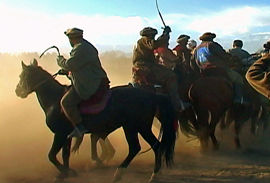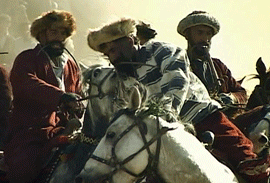DOKU.ARTS
Zeughauskino Berlin
19.09.–14.10.2012

Combat Chorus, Cavalos de Goethe
In January 2002, the Biennale of São Paulo sent Arthur Omar to Afghanistan to visit the site of the recently destroyed Buddha statues.
Ten years later, Arthur Omar edited the material and made both a short and a long documentary essay, focussing on the activities of the Afghani people. Combat Choir documents the rehearsals of a male choir. Os Cavalos de Goethe is an experimental documentary filmed with a small mini-DV handycam during a Buzkashi game. The images of horses, men and a headless goat are almost suspended in time, through special visual effects.
A poem by Eliot, a String Quartet by Morton Feldman, Goethe’s Theory of Color and an enigmatic poem in the Afghan language are all invited to re-enact the eternal combat between light and darkness, history and oblivion, horror and ecstasy. The change of speed during the film reveals a new meaning to an old war.

Arthur Omar
Arthur Omar is one of the most eclectic artists and experimental filmmakers in Brazil. Since the 1970s he has developed new methods of visual anthropology in his documentaries, photography, texts and video installations. The New York Museum of Modern Art held a retrospective dedicated to his films and videos in 1999. Arthur Omar participated twice at the Biennale in São Paulo. His film Triste Trópico (1974) is considered to be one of the classics of Brazilian cinema. Omar has published several books about photography and theory, among them Antropologia da Face gloriosa (1997), O Esplendor dos Contrários (2002) and Viagem ao Afeganistão (2010, with a foreword by Antonio Negri).